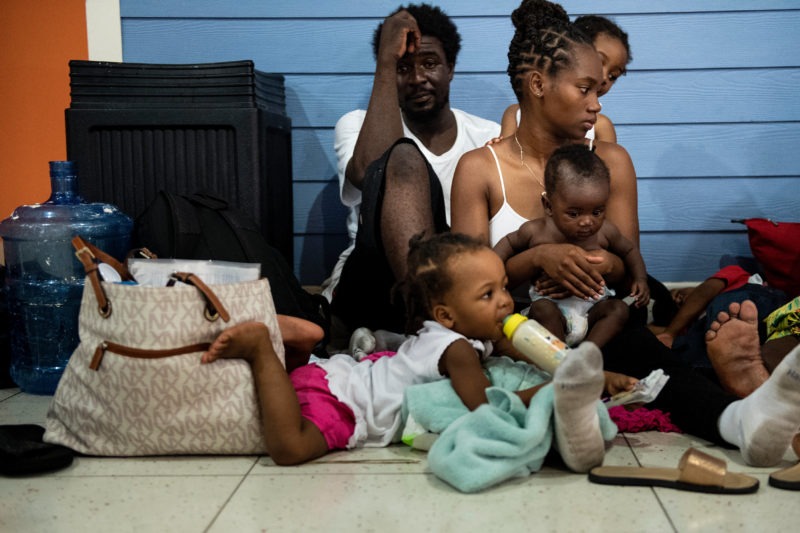Grim search for bodies in ravaged Bahamas as survivors await relief
Ronald Samuel and his wife, Kimberley Samuel, shelter with their children at Marsh Harbor airport in the Bahamas (Brendan Smialowski)
Marsh Harbour (Bahamas) (AFP) – Mortuary workers carried out the grim task of searching for bodies in heaps of rubble on Friday as dazed survivors of Hurricane Dorian waited for relief from the Category 5 storm that ravaged the northern Bahamas.
At least 30 deaths have been reported from the monster storm but hundreds — perhaps thousands — of people are missing and Bahamian officials said the final toll could be “staggering.”
Thousands of people were left homeless on the hardest-hit islands of Grand Bahama and Abaco and the scale of the devastation has left many wondering if Abaco, in particular, can ever be rebuilt.
“Abaco Island is like a ghost town,” said Mark Duvinie, a resident of Marsh Harbour, the largest town on Abaco, which had been home to more than 15,000 people. “No electricity, no water, no nothing.”
“I honestly believe Abaco is finished,” said Thaah Hepburn, another resident of Marsh Harbour. “Absolutely everything is gone.”
“I don’t think people are going to invest anymore because of the devastation,” Hepburn said. “It’s a chance I don’t think people are willing to take.”
Haida Guillaume, another Marsh Harbour resident, was slightly more optimistic.
“Nothing is impossible but it will take a long long time to recover,” Guillaume said. “It’s 100 percent devastated all over.”
A multi-national relief effort was stepping up on Friday but it was hampered by damage to airport runways and downed communications.
Some Abaco residents expressed frustration with the wait for food and shelter and evacuation to other islands.
“We’re stuck for now,” said David Bienami of Marsh Harbour. “We’ve got plans to move but we don’t know when.”
“No water, no food,” said James Whell, also of Marsh Harbour. “My plan is to leave, find some other place to live.”
– Landfall in Outer Banks –
According to UN relief officials, more than 70,000 people — virtually the entire population of Grand Bahama and Abaco — are in need of assistance after the storm reduced homes to matchsticks and destroyed their livelihoods.
As survivors began the first steps in rebuilding their shattered lives, arrangements were being made to take care of the dead from the storm.
Bahamian Health Minister Duane Sands said extra morticians and refrigerated coolers to store bodies were being sent to the affected islands.
Mortuary workers in white hazmat suits, blue gloves and masks could be seen in Marsh Harbour carrying corpses encased in green bodybags and loading them onto flatbed trucks.
Of the eventual death toll, Sands declared: “Let me say that I believe the number will be staggering.”
“Literally hundreds, up to thousands, of people are still missing,” Joy Jibrilu, the director general of the Bahamian tourism and aviation ministry, told CNN.
Dorian made landfall meanwhile in the United States as a Category 1 hurricane packing winds of nearly 90 miles per hour (150 kilometers per hour).
The Miami-based National Hurricane Center (NHC) said the slow-moving storm made landfall at Cape Hatteras on North Carolina’s Outer Banks, the finger-like barrier islands off the coast.
Thousands of coastal residents of US states from Florida to Virginia had been fearing the worst from the powerful storm but the East Coast largely escaped unscathed.
Some flooding occurred in the historic city of Charleston, South Carolina, and tens of thousands of residents lost electricity but no major damage was reported.
At 11:00 am (1500 GMT), the NHC said Dorian was moving in a north-easterly direction up the Atlantic coast at 17 mph (28 kph).
It said Dorian was expected to weaken as it moves up the coast and the center of the storm should move to the southeast of New England on Friday night and across Nova Scotia late Saturday.
Disclaimer: Validity of the above story is for 7 Days from original date of publishing. Source: AFP.


